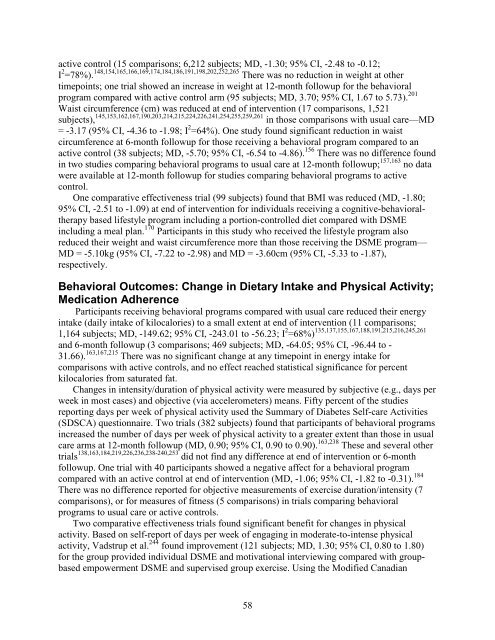Behavioral Programs for Diabetes Mellitus
diabetes-behavior-programs-report-150924
diabetes-behavior-programs-report-150924
- No tags were found...
Create successful ePaper yourself
Turn your PDF publications into a flip-book with our unique Google optimized e-Paper software.
active control (15 comparisons; 6,212 subjects; MD, -1.30; 95% CI, -2.48 to -0.12;<br />
I 2 =78%). 148,154,165,166,169,174,184,186,191,198,202,252,265 There was no reduction in weight at other<br />
timepoints; one trial showed an increase in weight at 12-month followup <strong>for</strong> the behavioral<br />
program compared with active control arm (95 subjects; MD, 3.70; 95% CI, 1.67 to 5.73). 201<br />
Waist circumference (cm) was reduced at end of intervention (17 comparisons, 1,521<br />
subjects), 145,153,162,167,190,203,214,215,224,226,241,254,255,259,261 in those comparisons with usual care—MD<br />
= -3.17 (95% CI, -4.36 to -1.98; I 2 =64%). One study found significant reduction in waist<br />
circumference at 6-month followup <strong>for</strong> those receiving a behavioral program compared to an<br />
active control (38 subjects; MD, -5.70; 95% CI, -6.54 to -4.86). 156 There was no difference found<br />
in two studies comparing behavioral programs to usual care at 12-month followup; 157,163 no data<br />
were available at 12-month followup <strong>for</strong> studies comparing behavioral programs to active<br />
control.<br />
One comparative effectiveness trial (99 subjects) found that BMI was reduced (MD, -1.80;<br />
95% CI, -2.51 to -1.09) at end of intervention <strong>for</strong> individuals receiving a cognitive-behavioraltherapy<br />
based lifestyle program including a portion-controlled diet compared with DSME<br />
including a meal plan. 170 Participants in this study who received the lifestyle program also<br />
reduced their weight and waist circumference more than those receiving the DSME program—<br />
MD = -5.10kg (95% CI, -7.22 to -2.98) and MD = -3.60cm (95% CI, -5.33 to -1.87),<br />
respectively.<br />
<strong>Behavioral</strong> Outcomes: Change in Dietary Intake and Physical Activity;<br />
Medication Adherence<br />
Participants receiving behavioral programs compared with usual care reduced their energy<br />
intake (daily intake of kilocalories) to a small extent at end of intervention (11 comparisons;<br />
1,164 subjects; MD, -149.62; 95% CI, -243.01 to -56.23; I 2 =68%) 135,137,155,167,188,191,215,216,245,261<br />
and 6-month followup (3 comparisons; 469 subjects; MD, -64.05; 95% CI, -96.44 to -<br />
31.66). 163,167,215 There was no significant change at any timepoint in energy intake <strong>for</strong><br />
comparisons with active controls, and no effect reached statistical significance <strong>for</strong> percent<br />
kilocalories from saturated fat.<br />
Changes in intensity/duration of physical activity were measured by subjective (e.g., days per<br />
week in most cases) and objective (via accelerometers) means. Fifty percent of the studies<br />
reporting days per week of physical activity used the Summary of <strong>Diabetes</strong> Self-care Activities<br />
(SDSCA) questionnaire. Two trials (382 subjects) found that participants of behavioral programs<br />
increased the number of days per week of physical activity to a greater extent than those in usual<br />
care arms at 12-month followup (MD, 0.90; 95% CI, 0.90 to 0.90). 163,238 These and several other<br />
trials 138,163,184,219,226,236,238-240,253 did not find any difference at end of intervention or 6-month<br />
followup. One trial with 40 participants showed a negative affect <strong>for</strong> a behavioral program<br />
compared with an active control at end of intervention (MD, -1.06; 95% CI, -1.82 to -0.31). 184<br />
There was no difference reported <strong>for</strong> objective measurements of exercise duration/intensity (7<br />
comparisons), or <strong>for</strong> measures of fitness (5 comparisons) in trials comparing behavioral<br />
programs to usual care or active controls.<br />
Two comparative effectiveness trials found significant benefit <strong>for</strong> changes in physical<br />
activity. Based on self-report of days per week of engaging in moderate-to-intense physical<br />
activity, Vadstrup et al. 244 found improvement (121 subjects; MD, 1.30; 95% CI, 0.80 to 1.80)<br />
<strong>for</strong> the group provided individual DSME and motivational interviewing compared with groupbased<br />
empowerment DSME and supervised group exercise. Using the Modified Canadian<br />
58


